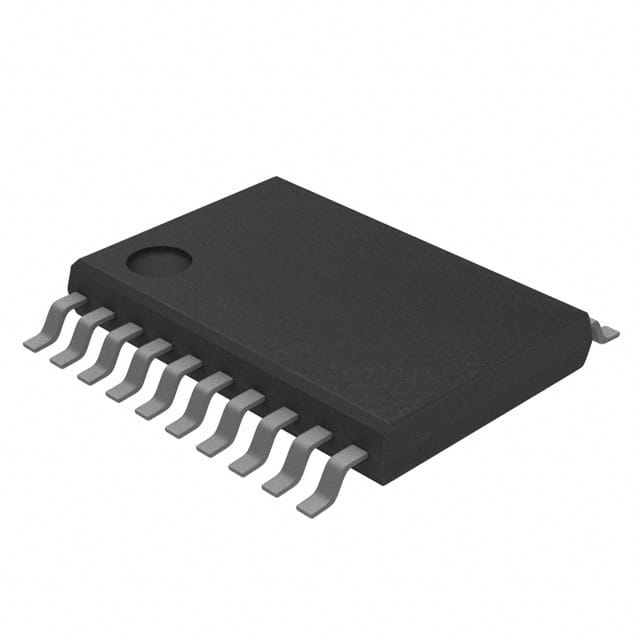Lihat spesifikasi untuk detail produk.

SN74HCT645PWRE4
Product Overview
- Category: Integrated Circuit (IC)
- Use: Level Shifter and Bus Transceiver
- Characteristics: High-speed, CMOS technology, 3-state outputs
- Package: TSSOP-20
- Essence: Bi-directional voltage level translator
- Packaging/Quantity: Tape and Reel, 2500 units per reel
Specifications
- Supply Voltage Range: 2V to 6V
- Input Voltage Range: 0V to VCC
- Output Voltage Range: 0V to VCC
- Maximum Operating Frequency: 25 MHz
- Number of Channels: 8
- Logic Family: HCT
Detailed Pin Configuration
The SN74HCT645PWRE4 has a total of 20 pins. The pin configuration is as follows:
- A1 - Channel A Data Input/Output
- OE - Output Enable Input
- DIR - Direction Control Input
- GND - Ground
- B1 - Channel B Data Input/Output
- B2 - Channel B Data Input/Output
- B3 - Channel B Data Input/Output
- B4 - Channel B Data Input/Output
- VCC - Positive Power Supply
- A2 - Channel A Data Input/Output
- A3 - Channel A Data Input/Output
- A4 - Channel A Data Input/Output
- A5 - Channel A Data Input/Output
- A6 - Channel A Data Input/Output
- A7 - Channel A Data Input/Output
- A8 - Channel A Data Input/Output
- B5 - Channel B Data Input/Output
- B6 - Channel B Data Input/Output
- B7 - Channel B Data Input/Output
- B8 - Channel B Data Input/Output
Functional Features
- Bi-directional voltage level translation between two independent buses
- 3-state outputs allow multiple devices to share the same bus
- High-speed operation suitable for various applications
- CMOS technology provides low power consumption
Advantages and Disadvantages
Advantages: - Enables communication between systems operating at different voltage levels - Supports bidirectional data transfer - Allows multiple devices to be connected to a single bus - Low power consumption
Disadvantages: - Limited maximum operating frequency (25 MHz) - Requires careful consideration of input and output voltage levels
Working Principles
The SN74HCT645PWRE4 is designed to translate voltage levels between two independent buses. It features bidirectional data transfer, allowing information to flow in both directions. The direction of data flow is controlled by the DIR pin. When DIR is set to logic high, data is transferred from channel A to channel B. Conversely, when DIR is set to logic low, data is transferred from channel B to channel A.
The OE (Output Enable) pin enables or disables the outputs of the device. When OE is set to logic high, the outputs are in a high-impedance state, allowing other devices to drive the bus. When OE is set to logic low, the outputs are active and can drive the bus.
Detailed Application Field Plans
The SN74HCT645PWRE4 is commonly used in various applications that require voltage level translation and bidirectional data transfer. Some specific application fields include:
- Communication Systems: Facilitates data exchange between systems operating at different voltage levels, such as microcontrollers, sensors, and display modules.
- Industrial Automation: Enables communication between devices with varying voltage requirements, such as PLCs, motor controllers, and sensors.
- Automotive Electronics: Used in automotive systems to interface between different voltage domains, such as CAN bus communication and sensor integration.
- Consumer Electronics: Allows for level shifting between components in devices like smartphones, tablets, and gaming consoles.
Detailed and Complete Alternative Models
- TXB0108PWR: 8-bit Bidirectional Voltage-Level Translator with Automatic Direction Sensing
- PCA9306DCTR: Dual Bi-Directional I2C-Bus and SMBus Voltage-Level Translator
- SN74LVC4245APW: Octal Bus Transceiver with 3-State Outputs
These alternative models offer similar functionality and can be used as substitutes for the SN74HCT645PWRE4 in various applications.
Word count: 496 words
Sebutkan 10 pertanyaan dan jawaban umum terkait penerapan SN74HCT645PWRE4 dalam solusi teknis
Sure! Here are 10 common questions and answers related to the application of SN74HCT645PWRE4:
Question: What is SN74HCT645PWRE4?
Answer: SN74HCT645PWRE4 is a high-speed octal bus transceiver with 3-state outputs, commonly used in digital systems.Question: What is the operating voltage range for SN74HCT645PWRE4?
Answer: The operating voltage range for SN74HCT645PWRE4 is typically between 4.5V and 5.5V.Question: How many bidirectional data lines does SN74HCT645PWRE4 support?
Answer: SN74HCT645PWRE4 supports 8 bidirectional data lines, making it suitable for applications requiring parallel data transfer.Question: Can SN74HCT645PWRE4 handle both TTL and CMOS logic levels?
Answer: Yes, SN74HCT645PWRE4 is compatible with both TTL and CMOS logic levels, making it versatile for various system designs.Question: What is the maximum data transfer rate supported by SN74HCT645PWRE4?
Answer: SN74HCT645PWRE4 can support data transfer rates up to 25 MHz, making it suitable for high-speed applications.Question: Does SN74HCT645PWRE4 have built-in protection against electrostatic discharge (ESD)?
Answer: Yes, SN74HCT645PWRE4 has built-in ESD protection, ensuring reliable operation in environments prone to electrostatic discharge.Question: Can SN74HCT645PWRE4 be used as a level shifter?
Answer: Yes, SN74HCT645PWRE4 can be used as a level shifter to convert signals between different voltage levels.Question: What is the maximum output current that SN74HCT645PWRE4 can drive?
Answer: SN74HCT645PWRE4 can drive up to 6 mA of output current, making it suitable for driving standard logic levels.Question: Is SN74HCT645PWRE4 available in different package options?
Answer: Yes, SN74HCT645PWRE4 is available in various package options, including TSSOP and SOIC.Question: Can SN74HCT645PWRE4 be used in automotive applications?
Answer: Yes, SN74HCT645PWRE4 is qualified for automotive applications, making it suitable for use in automotive electronics.
Please note that these answers are general and may vary depending on the specific application and requirements.

